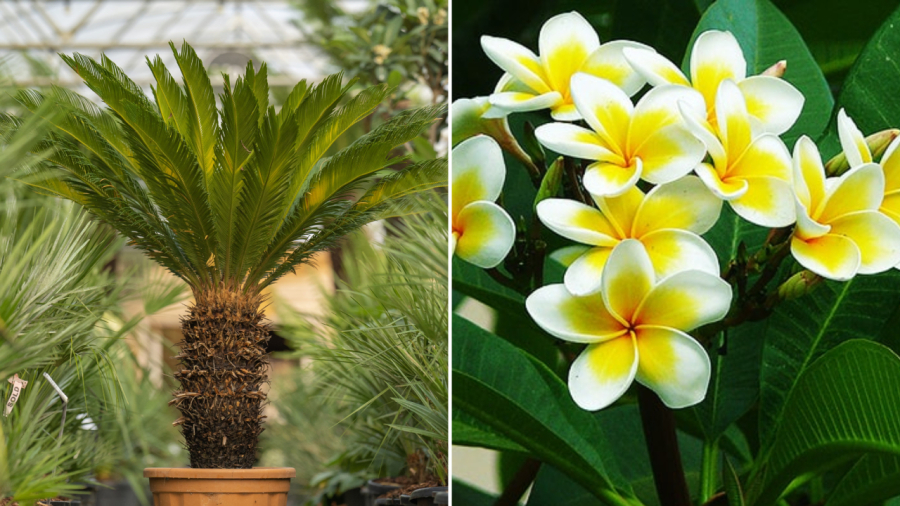Sago Palm: A Symbol of Longevity and Everlasting Life
The Sago Palm, a long-living perennial, is a popular choice for families to plant in mausoleum grounds. Often planted symmetrically at the entrance, flanking the tomb, or closely grouped to form a protective barrier. In Feng Shui belief, the Sago Palm represents longevity and eternity. Its leaves remain evergreen and sturdy, creating an aura of solemnity. Planting this tree near a grave not only enhances the dignity of the deceased’s resting place but also conveys the descendants’ wishes for their ancestors’ blessings in career and financial matters.

Sago Palm (left) and Temple Tree are ideal plants for mausoleum settings.
Temple Tree: A Sacred Plant in Buddhism
The Temple Tree, also known as the Indian Tulip Tree, is commonly planted at places of worship such as temples and clan shrines, as well as near graves. In Buddhist belief, this tree belongs to the ‘heavenly strong’ category, symbolizing the vital energy and soul of the heavens, earth, and universe.
Folk belief holds that the Temple Tree absorbs life force from the sky and transfers it to the earth and water. Thus, planting it near the family tomb is thought to bring peace to the deceased and a smooth, fulfilling life for their descendants.
Chrysanthemums: A Traditional Offering to Ancestors
Chrysanthemums are familiar flowers, often presented on occasions like the full moon festival, the first day of the month, and death anniversaries. They can be planted near graves as decorative flowers, with a variety of colors and forms to choose from, such as yellow, white, or Immortality chrysanthemums.
Planting or offering chrysanthemums expresses the descendants’ respect and gratitude toward their ancestors and the deceased.

Chrysanthemums and Bougainvillea not only beautify the resting place but also carry profound meanings.
Bougainvillea: A Colorful and Low-Maintenance Choice
While Bougainvillea is commonly known for its ornamental value in home gardens, providing shade and vibrant colors, it is also an excellent choice for planting near graves. Bougainvillea thrives year-round, requiring minimal care, and its flexible branches can be shaped into various styles.
Planting Bougainvillea near a grave not only beautifies the sacred space but also brings peace and a sense of well-being to the deceased.
Chinese Peony: A Symbol of Luck and Respect
The Chinese Peony, with its deep green leaves and large clusters of red, orange, or yellow flowers, is often planted in home gardens to attract luck and prosperity.
This flower is also an excellent choice for planting near graves, adding solemnity to the resting place and demonstrating the descendants’ reverence for their ancestors.

Chinese Peony and Iron Tree are ideal for planting near ancestral graves.
Iron Tree: A Feng Shui Favorite for Luck and Protection
The Iron Tree is revered in Feng Shui for bringing good fortune and prosperity to its owners. Besides being planted in homes, it is also suitable for graves, especially new ones or those that have been recently relocated.
It is believed that planting an Iron Tree near a grave brings peace and tranquility to the deceased. Doing so also symbolizes the descendants’ wish for their ancestors’ blessings in health, career success, and smooth sailing in life.
Information provided is for reference and exploration only.
The Chills of Hanoi’s Winter: 20+ Romantic Poems to Warm Your Heart
Winter in Hanoi is a season of romance and inspiration. The gentle drizzle and chilly breeze set the perfect backdrop for poets to pen their thoughts and craft beautiful verses. The city’s winter ambiance has time and again stirred the creative minds of many, resulting in a plethora of soulful poetry.






































